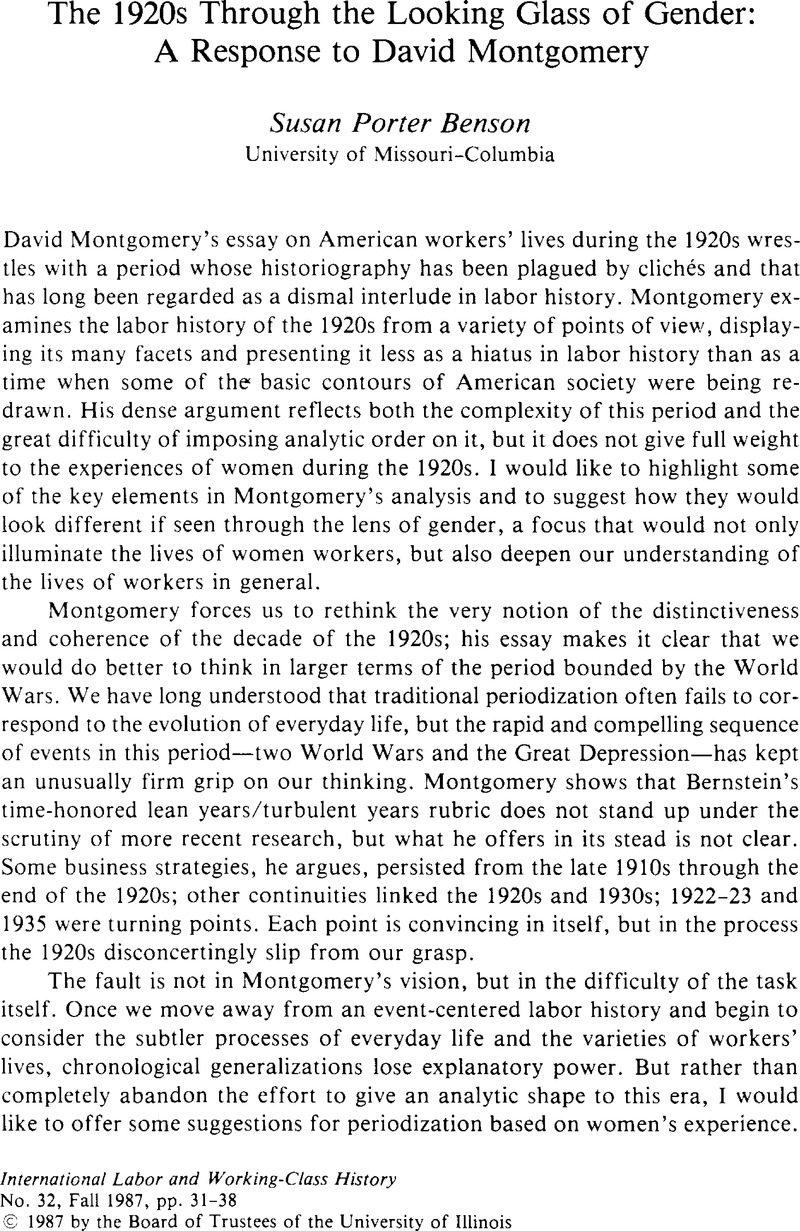Published online by Cambridge University Press: 16 December 2008

My thanks to Tani Barlow, Edward Benson, Dina Copelman, David Roediger, and Sharon Strom for their extraordinarily helpful and perceptive comments on a draft of this critique.
1. Frederickson, Mary, “‘I Know Which Side I'm On’: Southern Women in the Labor Movement in the Twentieth Century,” in Women, Work and Protest: A Century of U.S. Women's Labor History, ed. Milkman, Ruth (Boston, 1985), 164.Google Scholar
2. Kessler-Harris, Alice, “Problems of Coalition-Building: Women and Trade Unions in the 1920s,” in Women, Work and Protest: A Century of U.S. Women's Labor History, 126.Google Scholar
3. Sealander, Judith, As Minority Becomes Majority: Federal Reaction to the Phenomenon of Women in the Work Force, 1920–1963 (Westport, Conn., 1983).Google Scholar
4. Kessler-Harris, , “Problems,” 123.Google Scholar
5. Frederickson, , “I Know,” 166–67.Google Scholar
6. Waldinger, Roger, “Another Look at the International Ladies' Garment Workers' Union: Women, Industry Structure and Collective Action,” in Milkman, , ed., Women, Work, and Protest, 102–3.Google Scholar
7. Kornbluh, Joyce L. and Frederickson, Mary, Sisterhood and Solidarity: Workers' Education for Women, 1914–1984 (Philadelphia, 1984).Google Scholar
8. Waldinger, , “Another Look,” 97–101Google Scholar; Kessler-Harris, , “Problems,” 126–31.Google Scholar
9. Kessler-Harris, , “Problems,” 114.Google Scholar
10. “Vital Need of the Salespeople Today,” Retail Clerks International Advocate 21 (08 1920): 19.Google Scholar
11. On women's favorable earning possibilities in the textile industry, see Hareven, Tamara K., Family Time and Industrial Time: The Relationship Between the Family and Work in a New England Industrial Community (Cambridge, 1982), 428.Google Scholar
12. Jones, Jacqueline, Labor of Love, Labor of Sorrow: Black Women, Work and the Family from Slavery to the Present (New York, 1985), 160–65.Google Scholar
13. On office work, see Strom, Sharon, Beyond the Typewriter: Women and the Transformation of Office Work (forthcoming).Google Scholar
14. I make this argument in “‘The Clerking Sisterhood’: Rationalization and the Work Culture of Saleswomen in American Department Stores, 1890–1960,” Radical America 12 (03-04 1978)Google Scholar, repr. in Workers' Struggles, Past and Present: A “Radical America” Reader, ed. Green, James (Philadelphia, 1983).Google Scholar Sharon Strom develops this point in her forthcoming book.
15. Benson, Susan Porter, Counter Cultures: Saleswomen, Managers, and Customers in American Department Stores, 1890–1940 (Urbana, 1986), 164–65.Google Scholar
16. Strom, , Beyond the Typewriter.Google Scholar
17. “Vital Need of the Salespeople Today,” 16.Google Scholar
18. Peiss, Kathy, Cheap Amusements: Working Women and Leisure in Turn-of-the-Century New York (Philadelphia, 1986).Google Scholar
19. Conway, H. J., “A Woman May Change Her Mind,” Retail Clerks International Advocate 29 (09 1922): 15.Google Scholar
20. Conway, H. J., “Not How Much But How Little,” Retail Clerks International Advocate 29 (04 1922): 16.Google Scholar